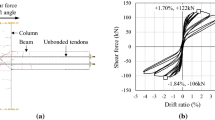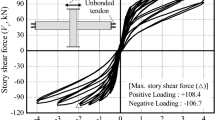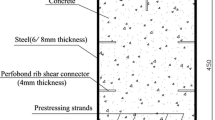Abstract
To effectively evaluate the actual stress level of prestressed concrete (PC) beams in service, the stress assessment method of prestressed tendons in PC structures after cracking is proposed based on incompatible deformation of the cracked structure and the stiffness reduction model. The stiffness reduction model of the cracked beam is determined by experiment data and plastic hinge theory. The measured mid-span deflection was used to solve the stress of the PC beam, and the stress calculation formula was derived. The experimental study was carried out on three specimens of prestressed concrete T-shaped model beam with 6 m length and one 30 m box beam in an actual engineering project. This method is used to estimate the actual stress level of model (PC) beams and 30 m box girders before the yielding of longitudinal reinforcement. Experimental results are compared with the measured data; the results show that the stress of the prestressing tendons estimated by this method is in good agreement and has a specific safety margin, which can evaluate the actual state of the prestressing tendons of PC structures in service. It is concluded that incompatible deformation significantly influences the stress level of the prestressing tendons of PC structures after cracking. Thus, it avoids the unsafe consequences caused by the evaluation according to the design specifications. Moreover, it provides a simplified method for assessing the actual state of the PC structure in service.
























Similar content being viewed by others
Data availability statement
Some or all data, models, or code generated or used during the study are proprietary or confidential in nature and may only be provided with restrictions.
References
Zhang W et al (2017) Test error sensitivity for methods of testing prestressed friction loss. J Bridge Eng 23(2):04171401
Wang L et al (2017) Failure analysis of corroded PC beams under flexural load considering bond degradation. Eng Fail Anal 73:11–24
Liu L-J, He S-H, Zhao X-X (2005) Effective prestress computation of existing PC Simply supported beam. J Traffic and Transp Eng
Gong W-M, Zhang C-J, Liu Yu-X (1966) Gray prediction of long-term loss for prestress. J Nanjing Architect Civil Eng Inst
Xiong Z-Y, Wang Y-J (2003) Energy method for stress calculation of unbonded prestressed concrete statically indeterminate structures. Constr Struct 04:76–77
Luo B et al. (2012) Techniques of reverse drawing detection for of prestress under anchor. Technol Highway Transp
Qian Y-J, Che H-M (1988) Calculation of stress and deflection of unbonded partially prestressed concrete beams under fatigue load. Sichuan Build Sci
Yang G-L, Li R (2008) Development and prospect of prestress loss detection method for prestressed concrete beams. Sichuan Build Sci
Sukhvarsh J, Milad MS (1985) Dynamic stiffness and vibration of reinforced concrete beams. ACI J 82(2):196–202
Zhang K, Jianzhang C, Yi Z (2018) Study on the quantitative determination of effective stress of steel strand based on anti-rahah. IOP Conf Ser 439(4):042063
Peng Z (2018) Inspection mechanism and experimental study of prestressed reverse tension method under PC beam bridge anchorage. IOP Conf Ser 128(1):012106
Takeuchi H et al (2017) Structural analysis and evaluation of actual PC bridge using 950 keV/3.95 MeV X-band linacs. J Phys 874(1):012105
Hu D, Zheng-Qing C (2004) Computation of stress loss in prestressed steel due to anchorage set considering the function of reverse-friction in PC members. China J Highway Transp
Nagatani T (2018) Fatigue strength of highway bridge pc slabs due to wheel loads. High tech concrete: where technology and engineering meet. Springer, Cham, pp 2152–2161
Biswal S, Ramaswamy A (2016) Measurement of existing prestressing force in concrete structures through an embedded vibrating beam strain gauge. Measurement 83:10–19
Cui N et al (2015) Experimental study on prestress loss of short tendons applied in the cable-stayed bridge PC pylon. IJSCER. https://doi.org/10.18178/ijscer.4.3.259-264
Glisic B (2018) Long-term evaluation of prestress losses in concrete bridges using long-gauge fiber optic sensors. No. CAIT-UTC-NC-48
Ye X, Zhuo S, Guoqing H (2017) Assessment of the current state of internal force and the optimization of cable force for an existing long-span pre-stressed concrete (PC) cable-stayed bridge. Open Civil Eng J 11(1):572–585
Sun Y et al (2018) Three-dimensional reinforcement design method and program realization for prestressed concrete box-girder bridges based on a specific spatial lattice grid model. Eng Struct 175:822–846
ElBatanouny MK et al (2015) Condition assessment of prestressed concrete beams using cyclic and monotonic load tests. ACI Struct J. https://doi.org/10.14359/51687181
Cavell DG, Waldron P (2001) A residual strength model for deteriorating post-tensioned concrete bridges. Comput Struct 79(4):361–373
Sawyer HA Jr (1965) Design of concrete frames for two failure stages. ACI Special Publication, London
Ganesh K, Sekar SK (2018) A review of behaviour of externally prestressed beams. Int J Civil Eng Technol 9(7):382–389
Zhi Q, Jing RS, Zheng XG (2017) Prediction of soil creep deformation using unequal interval multivariable grey model. Appl Mech Mater 864:341–345
Fang Z-Z, Zong Z-H (1995) Compatible deformation method for ultimate stress of unbonded prestressed tendons. China Civil Eng J 1:55–65
Acknowledgements
This research was financially supported by “The Project of National Key Research & Development (2017YFC0806000)”, “Transportation Science and Technology Project of Jiangxi Province (2017C0005)”, and the "5511" Innovation Driven Project of Jiangxi Province (20165ABC28001).
Author information
Authors and Affiliations
Corresponding author
Additional information
Publisher's Note
Springer Nature remains neutral with regard to jurisdictional claims in published maps and institutional affiliations.
Rights and permissions
About this article
Cite this article
Shah, Y.I., Hu, Z. & Du, R. Stress evaluation of prestressed concrete beam based on cracking and incompatible deformation. J Civil Struct Health Monit 12, 1427–1442 (2022). https://doi.org/10.1007/s13349-022-00569-1
Received:
Revised:
Accepted:
Published:
Issue Date:
DOI: https://doi.org/10.1007/s13349-022-00569-1




